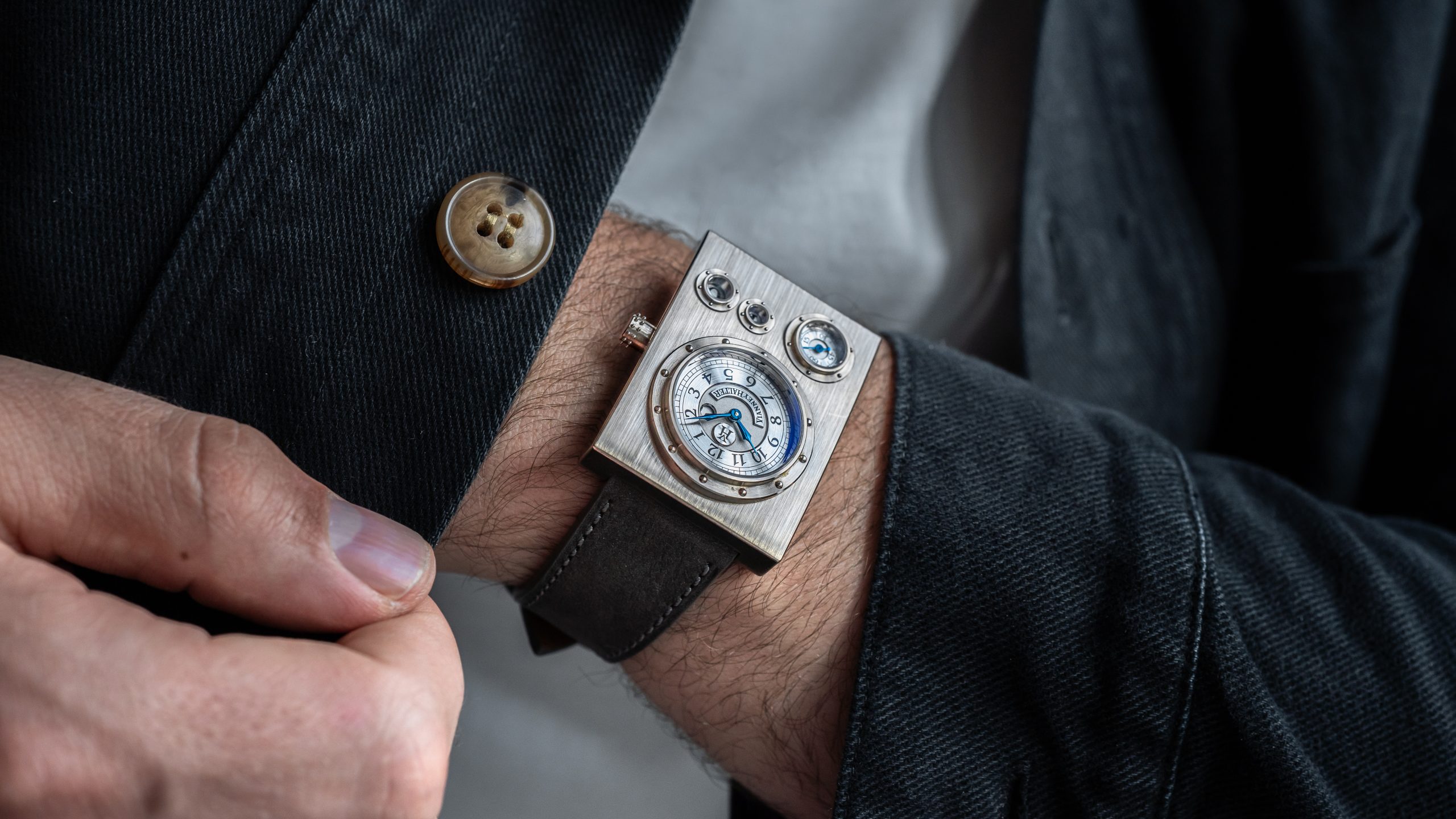Vianney Halter's watchmaking lies closer to science fiction art than traditional horology. This is the Trio, imagined as a bar of white gold for the wrist, and it certainly succeeded. Introduced as part of the legendary Future Past collection, it was a second album to the Antiqua with the same retro-futurist aesthetic sense. This is an 80-part ingot-inspired case, with 54 hand-pressed white gold rivets adorning its crown and apertures. Just like the Antiqua, its displays are entirely separated and given their own bezel. It is a view to an alternate futurist universe from one of the most storied eponymous independent watchmakers.
Vianney Halter's watches challenge the traditionally accepted forms of what a watch should be, often a bit whimsical and out of time or place but deadly serious when it comes to the craftsmanship. His youth was filled with science fiction and space odyssey, where he loved being transported to a different world. He was particularly fond of fictional time machines. All these years later, this thread has shown proud in the precious metals he hews.
At fourteen, he enrolled at the Ecole Horlogère de Paris, by seventeen a star student who left to work in restoration for a local retailer. In 1989, he doubled down and moved to Switzerland, joining a young François-Paul Journe and Denis Flageollet to start Techniques Horlogères Appliquées. THA was imagined by the three young watchmakers, now each established in their own right, to be a Skunkworks lab that larger companies could utilize for serious watchmaking endeavors. It worked. Their clients eventually included Breguet, Cartier, and AP. Towards the middle of the 90s THA disbanded as the three pursue their own ventures. This was where Vianney Halter began.
The initial series of watches Vianney Halter launched fell under an unbridled retro-futurist tone, influenced by prototype submarines, early locomotives, and the novelist Jules Verne. The forms were unlike any watch that had been seen to that date. Vianney named the collection Future Past, depicting a vision of the far future as seen from the past. This began with the extremely individual Antiqua, a perpetual calendar where every displayed element was given its own aperture. The Antiqua caught the attention of Philippe Dufour, who encouraged Halter to display at Baselworld and sponsored his AHCI membership. This saw more attention shown to both his wild vision in watchmaking and his company's work in commissions for other brands, shortly after he joined Max Büsser and Harry Winston to work on the Opus collection.
The Trio debuted in 2007, a rejection of traditional watch proportion and style in every aesthetic sense, but a bastion of traditional watchmaking technique. Vianney describes the Trio often as a 'wearable gold ingot', a literal brick of white gold for your wrist. Despite that, the same design sense which debuted on the Antiqua was in full force here, where each porthole window displays a separate element. Its Grande Date, where the two date digits are separated, is quite an unusual complication. Just 10 examples of the Trio were manufactured in white gold. Importantly, everything from the dial to the case and calibre is made by Vianney's hands.
The main dial is made in 7 separate pieces, brushed or frosted, chamfered where appropriate, hand-engraved, then hand-inked. The hands are blued steel in Halter's signature, intricately flared shape. The smaller aperture near 2 is a day/night indication for accurate setting. It is utterly perfect under a loupe, in the way that only names like Smith and Dufour are, despite sharing none of their reserved classicism.
Halter also mirrored the visual separation of elements in the architecture of the calendar module for the movement. Setting time forward or backwards further than 24 hours does not effect the date, which has an entirely separated crown position to setting. The Vianney Halter-designed automatic calibre VH205 appears manual at a glance through the sapphire back. Halter patented what he calls the 'mystery rotor', which uses a sapphire disc that bears its mass outside of the visual field of the exhibition caseback opening. That view is quite delighting, with great care and attention given by Vianney himself to the tiniest nuances of finishing: Côtes de Geneve, anglage, snailing, perlage, and black polish.
Further, this is one of few watches where the case is of equal finishing standard to the calibre. The monolithic 32x44mm white gold case sports many diminutive painstakingly hand-riveted elements, a hallmark of Vianney's style not seen elsewhere. The work is particularly impressive on the crown, which has to be felt to be believed. Its porthole apertures bear the same style of anglage on their edges as the bridges of the movement, just slightly finer in scale. The main case body contrasts a brushed upper and lower with mirror finished sides and one single chamfer between them. It is unlike anything else visually, but executed to the book in traditional hand finishing.
The Trio is a deviation from all watches which existed prior, a flag placed in the ground on behalf of creativity, personality, and independent watchmaking in its earliest years. Vianney Halter's Future Past collection, despite an initially polarizing reception, is widely accepted today as having given many other young independent watchmakers the bravery and audacity to reject conventions and defy expectations in their own ways. Vianney's was one of the bravest voices in an early 2000s world that cared little for independent watchmaking, unwavering and overflowing with creativity. Studying an early Antiqua, Classic, or Trio closely reveals Vianney's immense skills clearly, but also his perseverance, fascinations, and soul. Few watches feel so clearly inspired, seen through from imagination to metal directly. In his own words, 'When I’m making a watch, I’m working on this small dream, and even if it’s not possible to travel in time, with this tool, or instrument, you can dream.'























